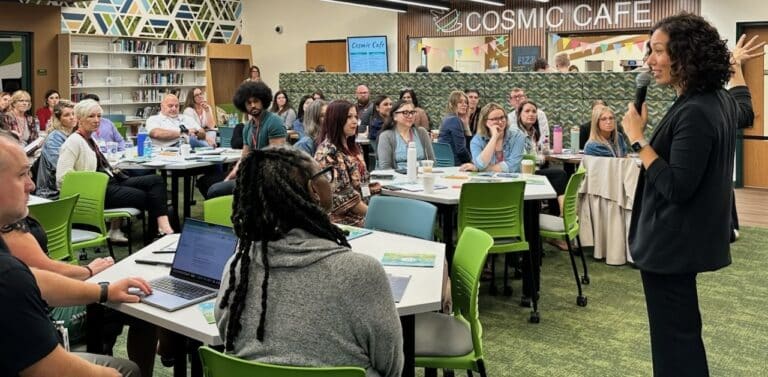This article was written by KnowledgeWorks consultant and former Senior Director of Strategic Initiatives Eric Toshalis, EdD.
Whether learning occurs in brick-and-mortar schools or in virtual environments, student engagement drives an impressive array of student outcomes. Few would argue, however, that counting log-ins to devices, appearances on video and audio conferencing platforms or emailing back a worksheet constitutes valid and useful measures of genuine engagement in learning. While these approaches existed before COVID-19, the current pandemic has laid bare how poorly, if at all, we’ve been addressing and assessing student engagement.
For a PDF version of this page, download it here.
Despite this observation, systems across the US are still trying to capture and enhance student engagement by tracking these very behaviors. As schools continue to refine their reopening plans or shift between in-person, hybrid and remote schooling, leaders and educators must replace these old lenses and bad proxies with better, more authentic measures of engagement that reflect the kinds of fluid learning environments our students are now experiencing regularly.
Further, recent events have underscored the enduring need for education systems to promote racial equity and to dismantle systemic structures that were designed to secure advantage primarily for White, middle-class students. An accurate accounting of engagement can and must attend to each student’s reasons for engaging and disengaging. The need to address these dual imperatives has existed for a long time. Right now, it couldn’t be more glaring.
In short, it’s time to move on. That’s why we’re providing an overview of the research on engagement alongside actionable practices that are appropriate, effective and equitable.
What is student engagement anyway?
Accurately understanding, assessing and promoting student engagement is important because engagement drives pretty much all major aspects of learning. As Michael J. Nakkula and I discussed in our 2012 paper, Motivation, Engagement and Student Voice, engagement is a robust predictor of students’:
- Academic achievement
- Behavior
- Experiences of alienation and withdrawal
- Grades
- Test scores
- Attendance / absenteeism
- Graduation
- Pushout / dropout
Researchers have discovered that engaged students tend to pay more attention, look more interested and act with more persistence in the face of challenges than their more disengaged peers.1 As long as supports and opportunities are sustained, the benefits of engagement typically build over time.2
Given these observations, it’s not surprising that engagement tends to be higher in learning environments with supportive teachers and peers, challenging and authentic tasks, opportunities for voice and choice, cultural responsiveness and risk-free opportunities to struggle.3,4,5
Studies have demonstrated that when students are engaged, their teachers tend to reciprocate by providing them with more motivational support and assistance. This response can create a virtuous cycle in which engaged students receive more positive feedback that in turn encourages greater engagement. On the flipside, when teachers perceive their students to be disengaged, they sometimes withhold needed supports and opportunities for growth. Some teachers even mistakenly locate motivational problems in the learner rather than in the learning context.6,7,8 Whether engagement becomes a vicious or virtuous cycle depends a great deal on the teacher and the learning environment. That’s as true in virtual learning environments as it is in traditional classrooms.
What is engagement in learning?
Engagement is the student’s investment in a given activity. It’s the result of a motivational and social process that culminates in a person’s choice to apply effort, persist through struggle, complete a task and resolve discriminatory experiences. To be engaged is to be interested and emotionally activated; to try. It’s the student saying, “Yes, I can and will attempt this task because I want to.”
To feel affirming and authentic to the learner, that attempt must carry at least a bit of self-driven spark. The student’s decision to engage emanates from an inner fire we all have which is to be true to ourselves and to accomplish something we value. In this way, engagement is a reckoning with the learner’s need to self-determine. It reminds us that we control neither the minds nor the actions of our students. Engagement research demonstrates that educators are actually quite dependent on students’ assent whenever we attempt to get anything done in the classroom — or via video chat.
Unfortunately, in education we often confuse compliance with assent and engagement. “Turn this in or get a zero,” we say. But this move is rarely as productive as approaches that prioritize self-direction. And compliance is often alienating to the student populations who least trust (with good reason) that school was built for them. If we want to engage students consistently and effectively we need to maximize their experiences of self-direction. This is because an engaged student is someone who is transitioning—at least partly on their terms—from the thinking and feeling of motivation to the growing and connecting of learning. Engagement marks the shift from thinking, “I want to do this,” to the action, “I am doing it.” That’s why it’s such an important concept to those who lead, support and design learning environments.
What makes a student want to engage?
This question can only be fully and accurately answered by each individual student. That unique person knows best what interests them, what makes them want to try and what holds their attention when challenges arise. Whatever the setting, the best path to student engagement is through relationships: getting to know each student and staying curious about their interests and experiences.
It’s also important to remember that engagement is a psychological and social phenomenon: it happens in and because of the shared learning environments we build with our students. That makes engagement a product of social forces that do not always function equitably.
For example, many students choose to disengage and to withdraw energy from learning activities when they perceive the situation to be unsafe, unfair, exclusionary, discriminatory, assimilative and/or hopeless. They want to bring their full selves to their most important work. (Doing so is easier for folks whose identities align with the dominant culture and is harder for those whose background and culture are marginalized.) If a student feels that the learning context threatens them, they may choose to withhold effort and participation. A student’s decision to disengage from what is perceived to be a toxic situation makes good psychological sense even when doing so may have negative academic or behavioral consequences. Learning to see the logic in students’ decisions to disengage is a great way to ensure that the learning environments we design for them match their needs.
Plus, our K-12 students are, well, young. They’re just learning to integrate concerns about identity, belonging, self-efficacy, smartness and relationship. Their choice to disengage may be impulsive and may lack nuance, but that doesn’t make it wrong. When inequities or microaggressions persist unchallenged in a learning environment, the choice to engage may seem fraught with danger. Arguments about whether there are any actual dangers in the learning environment are immaterial; it’s the perception that matters. But educators can help youth relax, lean in and use the most sophisticated parts of their developing brains when we ensure the learning environment remains inviting, supportive, collaborative and attentive to status differences that continue to drive so many unjust social and educational outcomes.
What should we do to increase student engagement?
Keeping the above caveats in mind, research confirms that most learners tend to respond positively to a set of core drivers of engagement. These drivers are described below, along with “do-now” suggestions and examples that can help you activate engagement in remote learning settings—or any learning environment.
Why is it important?
Educators and community members are able to open doors, supply tools, enrich learning and explain processes in ways that critically enhance engagement and supplement learning. Students with privilege tend to have these things in abundance, so an equitable approach to engagement will allocate resources where they’re most needed.
How do I make it happen?
Open doors, supply tools, broker relationships and explain processes. Take nothing for granted when it comes to resource access and opportunity; always ask whether students have what they need to be successful.
Why is it important?
Telling students you believe in them helps — a little. What really helps inspire engagement is showing students you believe they can achieve at the highest levels. Ask yourself: Do you know a single student without a gift or a talent worth developing?
How do I make it happen?
Establish and encourage a growth mindset orientation; resist and remove labels; stop all ridicule during cognitive struggle; avoid ability grouping; distribute rigor and depth of learning across so each student is challenged and supported to persist through struggle.
Why is it important?
Content must connect with students’ lives to maximize engagement. Distant “You’ll need this later” claims rarely motivate. Curriculum needs to be more immediate and more captivating. Dry textbooks will bore. Lively content that hooks student interest will engage.
How do I make it happen?
Use essential questions, inquiry-based lessons/unity, project-based learning, problem-based pedagogies, dilemmas, UDL, controversy and exposure to diverse communities’ ways of knowing to inspire curiosity and application of learning in real-world contexts.
Why is it important?
If there’s a mantra in adolescence, it’s “You’re not the boss of me.” Ignore that and students will ignore you. They need to individuate, feel intrinsically motivated, follow aspirations and feel as if the thing they’re doing is theirs. Give them opportunities to do those things, and they’ll show up, dive in and blow you away with their efforts.
How do I make it happen?
Find out what students want to study and how they want to study it; then wrap instruction and assessment around those interests and the competencies needed for students to demonstrate their learning. Put students in charge of identifying where they want to develop their expertise; then work with them to execute that plan.
Why is it important?
Our richest learning opportunities tend to be social. When brains access other brains with different funds of knowledge and alternative perspectives, learners are pushed to think with more complexity and less expediency. As the diversity of perspectives and contributions increase, so does the sophistication of the learning. Conversely, isolated one-to-one learning can stagnate cognitive processes and leave students stranded at the surface of issues and problems.
How do I make it happen?
Want complex thinkers? Provide complex problems in complex groups. Set up cooperative learning opportunities, ensure a diversity of perspectives in groups, assign rotating roles and incremental progress checks, monitor status differences and take time to check on process as much as product.
Why is it important?
“Be yourself” is about the worst advice you can give to a young person who hasn’t yet figured out who that self is. This is particularly true for students who experience chronic marginalization due to their race, class, gender identity, sexuality, linguistic heritage, disability, immigrant status or religion. All students will be more likely to engage academic work when they don’t have to hide parts of themselves to be taken seriously while doing it. Kids tend to engage most deeply when they can represent authentically. Let them.
How do I make it happen?
Ask yourself: Where in your curriculum, classroom or school are your students supported to show up as their full selves? Provide opportunities to experiment and lessons that require the testing of ideas, expressions, alliances, beliefs and memberships. Offer structured occasions where students can try out draft versions of their selves and see how they are received. Ensure such learning opportunities leave room to counter dominant judgments and consider whose contributions are considered authoritative.
Why is it important?
When learners recognize that they have the requisite skills and knowledge to be successful in a given activity, they are far more likely to engage and complete it. More than confidence, self-efficacy is an inventory of one’s capabilities matched against challenges. Once students see they have the tools, they’ll get to work. And here’s a cool thing: self-efficacy will increase over time if opportunities to grow persist and little wins abound.
How do I make it happen?
Provide specific cues in the learning environment so that students can see how they’ll use their knowledge, strategies, resources and relationships to succeed. Avoid bland assurances like “You can do it!” Instead, keep feedback focused how students can use the knowledge and skills they already have to promote far greater levels of engagement—and success.
Why is it important?
Sometimes we misperceive learners to be disengaged and unmotivated when their reason for withholding effort is far simpler: they haven’t yet learned how to get started and stay focused. Nobody is born with the knowledge of how to initiate and sustain attention amid distraction and challenge. We learn how to do that by watching how others do it, and by reflecting on whether our strategies yielded the kinds of outcomes we prefer.
How do I make it happen?
Teach students to monitor their attention, deal with distractions, set goals, self-evaluate and take breaks. Model these skills and separate their components into distinct moves. Have students practice, report results and share what works for them. Praise the activities of experimentation, evaluation and revision, not personal qualities such as smartness or persistence.
Why is it important?
Connect with students’ feelings and adapt your approaches when life circumstances make it hard for them to complete assignments. Simply listening may not solve students’ problems, but it will help learners realize that educators see them in their totality.
How do I make it happen?
Check assumptions, check in and listen for experiences and feelings that might make it hard to engage in learning. Know what students need and get them help. Suggest discrete signals students can give adults to communicate when they might need adaptations or additional supports.
Why is it important?
It’s hard to overestimate the kind of intrinsic appeal fun can have for learners. Anticipating and experiencing fun draws learners in, makes them relax, provides rewarding opportunities to bond with others and releases all kinds of feel-good chemicals in our bodies. One important warning, however: avoid competitive games. Competitions always produce losers, force learners to want to “save face” and elevate the motivation to work against one’s peers.
How do I make it happen?
Commit to frequent use of humor, silliness, games, adventures, novelty and surprises. It doesn’t have to be every day—weekly fun moments will generate students’ expectation that another one is just around the corner. Anticipation of fun is nearly as motivating as the fun itself.
Let’s engage!
As school doors or digital portals open for an unprecedented year, engagement is top on the list of issues educators are facing. Getting engagement right means students on screens, in masks or working offline. It means showing up motivated to learn, progressing in their educational journey, feeling safe, heard and cared for. It means we’re attending to the particular needs of our students most adversely impacted by the pandemic. And it means learning remains a joyful, social activity, no matter what modality must be used.
Throughout the next few months on this website and on social, we will be going deeper into core topics of engagement that are most pressing to frontline educators, policymakers and systems builders. We’ll be exploring questions such as:
- What does engagement in remote settings look like? What does it mean in virtual classrooms?
- How to calibrate grading and grading policy for interrupted learning so that it doesn’t cause students to further disengage?
- How can assessments for learning bolster engagement?
- In what ways can a broader ecosystem approach to learning enhance engagement while adding capacity to the teaching force during the pandemic and beyond?
- What should policymakers consider as they strive to increase student engagement with policy incentives and removal of policy barriers; and what might engagement during COVID-19 mean for accountability, assessment and accreditation policies?
We’ve compiled a list of resources designed to help educators implement these evidence-based practices at Students at the Center Hub.
Thanks to KnowledgeWorks Vice President of Impact and Improvement Rebecca E. Wolfe for contributions in writing and editing.
References:
- Klem, A. M., & Connell, J. P. (2004). Relationships matter: Linking teacher support to student engagement and achievement. Journal of School Health, 74(7), 262-273. doi:10.1111/j.1746-1561.2004.tb08283.x
- Appleton, J. J., Christenson, S. L., & Furlong, M. J. (2008). Student engagement with school: Critical conceptual and methodological issues of the construct. Psychology in the Schools, 45(5), 369-386. doi:10.1002/pits.20303
- Loera, G., Rueda, R., & Oh, Y. J. (2015). Learning and Motivational Characteristics of Urban Latino High School Youth. Urban Education, 53(7), 875-898. doi:10.1177/0042085915602536
- Fredricks, J. A., Parr, A. K., Amemiya, J. L., Wang, M.-T., & Brauer, S. (2019). What Matters for Urban Adolescents’ Engagement and Disengagement in School: A Mixed-Methods Study. Journal of Adolescent Research, 34(5), 491-527. doi:10.1177/0743558419830638
- Van Ryzin, M., Gravely, A., & Roseth, C. (2009). Autonomy, belongingness, and engagement in school as contributors to adolescent psychological well-being. Journal of Youth and Adolescence, 38(1), 1-12. Retrieved from http://dx.doi.org/10.1007/s10964-007-9257-4
- Furrer, C., & Skinner, E. (2003). Sense of relatedness as a factor in children’s academic engagement and performance. Journal of Educational Psychology, 95(1), 148-162. doi:10.1037/0022-0663.95.1.148
- Skinner, E. A., & Belmont, M. J. (1993). Motivation in the classroom: Reciprocal effects of teacher behavior and student engagement across the school year. Journal of Educational Psychology, <em85(4), 571-581. doi:10.1037/0022-0663.85.4.571
- Skinner, E. A., Kindermann, T. A., & Furrer, C. J. (2009). A motivational perspective on engagement and disaffection: Conceptualization and assessment of children’s behavioral and emotional participation in academic activities in the classroom. Educational and Psychological Measurement, 69(3), 493-525. doi:10.1177/0013164408323233





